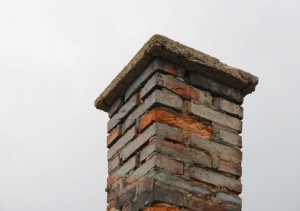It’s that time of year again: As the last snow and ice melts and warmer temperatures emerge, we begin to assess the damage of winter. We notice the cracks in sidewalks and see road crews out in force filling in potholes. This time of year, it’s important to evaluate winter’s effects on your chimney, as the same freeze-thaw cycle that damages the roadways and parking lots also can damage chimneys and other home masonry work.
How the freeze-thaw cycle affects your chimney
Masonry materials, especially brick, are extremely porous. That means that when they come in contact with water, whether it’s from rain, ice or snow, they soak up that water like a sponge. When the temperature drops, the water inside your chimney’s masonry can freeze and expand. That damages the masonry. Bricks can crack and crumble, or “spall,” just like roads and sidewalks do. That damage to your chimney can compromise its structure and its ability to contain the heat and smoke from your fires.
How to address freeze-thaw damage
Each spring, it’s important to take a look at your chimney and examine it for signs of freeze-thaw or water damage, including cracked bricks, crumbling mortar and discoloration. If you’re able to access the top of your chimney easily, you can inspect your chimney crown to see if it has sustained any freeze-thaw damage. Spring can be a great time for your annual chimney sweeping and inspection because it gives professionals a chance to examine your chimney for freeze-thaw damage and provides ample time to repair the damage over the warm spring or summer months. The good news is that most freeze-thaw damage can be repaired easily if it’s caught early enough. Ignoring freeze-thaw damage can lead to more severe, harder-to-fix and more expensive repairs down the road.
How to prevent freeze-thaw damage
There are ways to help prevent freeze-thaw damage and avoid the need for future masonry repairs. First, you should have a chimney cap securely installed atop your flue. That prevents water from pouring down the inner walls of your chimney and causing freeze-thaw damage to flue tiles. Your chimney crown also should be kept in good repair, as it helps keep water from running down the sides of your chimney. Waterproofing is the most effective way to protect your chimney from water and freeze-thaw damage. Waterproofing involves applying a solution to your chimney’s exterior that prevent it from absorbing any water while still allowing the masonry to “breathe” and exhaust moisture from your chimney.
If you notice the signs of freeze-thaw damage on your chimney, if you’d like to schedule your annual chimney inspection for this spring or if you’d like to hear more about ways to protect your chimney from water and freeze-thaw damage, call Clean Sweep Anne Arundel County. We can inspect your chimney, perform necessary repairs and help you protect your chimney moving forward. “We Make Chimneys Healthy!

